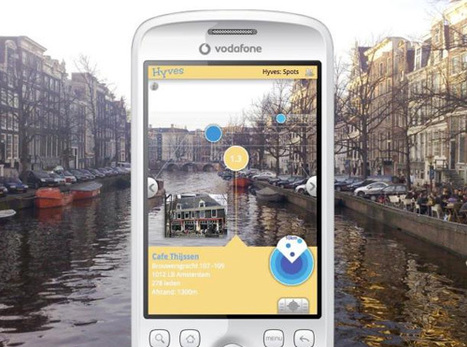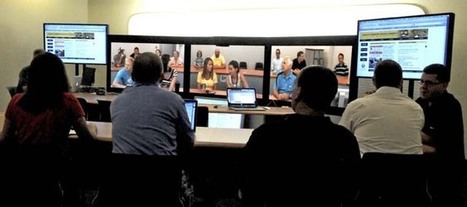 Your new post is loading...
 Your new post is loading...

|
Scooped by
Kim Flintoff
September 7, 2012 9:48 AM
|
A paper in which I revisit the research I conducted into the most engaged players in the Alternate Reality Game (ARG) Perplex City has just been published in the International Journal of Games Base... Alex Moseley is Educational Designer at the University of Leicester. He is a course designer, and conducts research in games-based learning, subject-based research skills delivery, social media, and museum games for education; he also teaches innovative courses in History and Museum Studies. He was recently awarded the title of University Teaching Fellow.

|
Scooped by
Kim Flintoff
September 7, 2012 9:01 AM
|
Late in July, I published my lists of wants for in-world features and technical features for a educational virtual world that I would build, had I time and money enough. Then I put the issue before 23 members of the Roundtable. Here is their list of wants:

|
Scooped by
Kim Flintoff
September 5, 2012 12:32 AM
|
Ford Australia creates the Holodeck Ford Australia engineers and designers are living in a virtual world, and loving it. The company has unveiled its new Virtual Reality Centre, a high tech digital evaluation and design environment. KF: The project required some heavy computing power and obviously a well-estab;ished set of design protocols. The project is an interesting case study for any students/teachers of 3D design, CAD, 3D visualisation and similar disciplines.

|
Suggested by
Learning Futures
September 2, 2012 8:49 PM
|
This is the 2012 LearnX Presentation that I did in Melbourne.

|
Rescooped by
Learning Futures
from Virtual Reality VR
September 2, 2012 8:43 PM
|
Editor’s note: This is a contributed post by Gabriela Jugaru, a tech enthusiast who is passionate about the mobile industry and gadgets. She’s a technology entrepreneur, co-founder of UnlockUnit.com.
Via Rui Guimarães Lima, Timo Ilomäki

|
Scooped by
Kim Flintoff
September 2, 2012 2:02 AM
|
Simulation & Training Technology Center... Research efforts in the Simulation and Training Technology MLP are directed at the conduct of fundamental and applied research as well as technology development. Training is the number one Warfighter outcome identified by the U.S. Training and Doctrine Command (TRADOC) for FY11. The pace and diversity of U.S. Army missions require training that is equally rapid, responsive, and tailorable. The advances in computing capability, the proliferation of nearly off-the-shelf platforms for training delivery, known gaps in training effectiveness of current approaches, and the cost of training all drive this research. Key areas of emphasis are intelligent agents for training and testing applications; immersive environments where the level and type of immersion are driven by the goals of using a simulation; the high-demand environment of simulations for the dismounted Soldier, simulations targeted at medical training and at applications where vehicle and terrain fidelity are critical; and advances in providing massive, real-time, distributed simulation for analysis and experimentation. See also: http://fvwc.army.mil/moses/planning-2/the-draft-participation-agreement/

|
Scooped by
Kim Flintoff
August 31, 2012 9:22 PM
|
a lecture at the course of Media Planning of prof. On May 17th 2012, we took part to prof. Marco Stancati’s course of Media Planning at La Sapienza University of Rome with a lecture on the scenarios offered by Augmented Reality to the creation of novel opportunities for communication and business.
Abstract Advanced three-dimensional (3D) virtual reality (VR) technology similar to that used by the film and computer game industries can allow educational developers to rapidly create realistic online virtual environments. This technology has been used to generate a range of online VR-based learning environments across a broad spectrum of industries and educational application areas. This idea is not new; flight simulators have been used for decades to train pilots for both commercial and military aviation. There are a number of lessons that can be learned from the industries that have successfully utilized virtual training and learning systems. Generic rules of thumb regarding the specification, development, application, and operation of these learning environments can be garnered from these industrial training systems and examined in an educational context. In this paper, an online VR-based system developed by the author, ViRILE (Virtual Reality Interactive Learning Environment), is introduced. This software is designed for use by undergraduate chemical engineers and simulates the configuration and operation of a polymerization plant. During the implementation of this and other visual learning environments, a number of complex operational problems were encountered that have required a number of innovative solutions and management procedures to be developed. The implementation of this and other similar systems is also discussed in this paper, and the lessons learned are extrapolated into general pedagogical guidelines to be considered for the development of VR-based online educational learning resources.

|
Scooped by
Kim Flintoff
August 27, 2012 1:49 AM
|
In other words, Leet Noobs is a story of collaborative, technology-mediated learning. To some extent, it's a story about how people experience learning in gaming environments, which educators should take an interest in because an unbelievable amount of learning happens in these online spaces. What was the last time you worked together in a 40 person group for months to figure out how to solve a puzzle, failing over and over again until you succeed?

|
Rescooped by
Kim Flintoff
from Pervasive Entertainment Times
August 26, 2012 7:54 PM
|
research mapping the future direction of locative media, which is essentially the convergence of our networked, real-time, digital world with the physical world we inhabit in our everyday lives. This was part of the "Best of Houston" panel showcasing some of the work from students in the University of Houston's Futures Studies graduate program. While all the content and slides are licensed under CC-Attribution, the audio recording is owned by World Future Society and Intelliquest Media. Audio has been provided with the express permission of both rights holders.
Via Gary Hayes

|
Suggested by
Learning Futures
August 25, 2012 9:52 AM
|
NMC Virtual Worlds is a program of the New Media Consortium. Our mission is to help learning-focused organizations explore the potential of virtual spaces in a manner that builds on community knowledge, is cost-effective, ...

|
Scooped by
Peter Mellow
August 23, 2012 9:40 PM
|
ARatDeakin shows how you can do all this through the power of the Deakin Motion.Lab and the forces of the Creative Arts disciplines at Deakin University.

|
Scooped by
Kim Flintoff
August 16, 2012 10:30 AM
|
Life after death ...the high tech way to interact... “Whoever is looking after my affairs when I die may make the decision not to switch that off,” Dr Arnold said. “I could then continue to correspond to people, continue to contribute to blogs, to discussion lists. Through video technology I could conference with people. For all intents and purposes, I could remain ‘alive’. That’s a prospect we need to consider.” KF: An interesting speculative report - I wonder if we might all be teaching well after we have ceased breathing? Or maybe our students might also be able to complete their studies posthumously? In a very real sense there may well be implications for teaching and learning that work to maintain significant characters in our schools and colleges beyond their life.
|

|
Suggested by
Learning Futures
September 7, 2012 9:30 AM
|
also showcases films from the best machinima in Second Life. Relax in fabulous surroundings and watch films from LEA MOM; the 48 hour Machinima; and the University of Western Australia's MACHINIMUWA contests.

|
Scooped by
Kim Flintoff
September 5, 2012 11:54 PM
|
Loyalist College in Belleville has been creating simulations for learning since 2006, using Second Life, an online virtual world. A description of one of the projects is included in this series under the title of Border Simulation – Student learning in a virtual world at Loyalist College.

|
Rescooped by
Kim Flintoff
from Virtual Student Fair Gallery
September 2, 2012 8:51 PM
|
Virtual (online) Student Fairs for applying to USA Colleges will still take place ... ... even if raining :-)
Via Shamblesguru

|
Rescooped by
Kim Flintoff
from Virtual Reality VR
September 2, 2012 8:48 PM
|
Last fall I demonstrated a couple of augmented reality (AR) apps to some of my workshop participants at the NESA Leadership Conference in...
Via Timo Ilomäki

|
Rescooped by
Learning Futures
from Virtual Reality VR
September 2, 2012 8:43 PM
|
Students write and produce movies for historic walking tours that can be accessed via Aurasma. How to merge technology and community involvement.
Via Mats Larsnäs, Timo Ilomäki

|
Scooped by
Kim Flintoff
August 31, 2012 10:11 PM
|
A handful of classrooms in Anoka-Hennepin high schools might appear equipped for surveillance rather than teaching to students returning from summer vacation next week. KF: This strategy has a lot to offer educational instiitutions that may find they have unsustainable course offerings dur to flagging enrolments. Creating partnerships that allow cohorts to connect via telepresence may mean that a viable class can be established as a cross-institutional undertaking.

|
Scooped by
Kim Flintoff
August 31, 2012 12:07 AM
|
Role play in face-to-face contexts has been shown to be a powerful teaching design at all levels of education. The arrival of e-learning makes it possible to engage with different types of role play, for example inter-national and inter-institutional collaborations, role plays blending online and face-to-face interaction, role plays blending synchronous and asynchronous media including recordings of the sessions, and role play within distance learning contexts. It is now possible to conduct elaborate and responsive role play activities where the identity of the participants is not immediately apparent, where they may use avatars or inhabit 3D virtual worlds as part of the role play. This paper charts the development of role-based e-learning over the past 20 years in Australia using simple e-learning technologies such as email and online discussion forums and compares this with emerging forms of the e-learning design which are adopting newer technologies in America, Britain and Asia.
The untapped potential of virtual game worlds to shed light on real world epidemics. Simulation models are of increasing importance within the field of applied epidemiology. However, very little can be done to validate such models or to tailor their use to incorporate important human behaviours. In a recent incident in the virtual world of online gaming, the accidental inclusion of a disease-like phenomenon provided an excellent example of the potential of such systems to alleviate these modelling constraints. We discuss this incident and how appropriate exploitation of these gaming systems could greatly advance the capabilities of applied simulation modelling in infectious disease research.

|
Scooped by
Kim Flintoff
August 27, 2012 1:47 AM
|
Influential research firm Gartner recently posted its 2012 "hype cycle" chart of emerging technologies, and there's a small but significant change: Virtual worlds, which were at the very bottom of the Trough of Disillusionment in Gartner's 2011... Back in 2007, by the way, Gartner predicted that 50 million people would use virtual worlds in 2011. If you count MMOs and web-based 2.5D virtual worlds in that category, the number was actually far more than that -- closer to 100 million.

|
Scooped by
Kim Flintoff
August 25, 2012 8:50 PM
|
tl;dr: If we want to see the metaverse happen in our lifetime, we need to invest our time, money, creativity, and resources into making it happen. " Which brings me back to the whole game thing. Back when Philip ran the Lab, Second Life was not a game. Under Rod’s leadership, a game is exactly what he’s trying to turn it into. My advice is: If you want to see the metaverse we imagined, then stop playing the perpetual hoping and waiting game that Second Life is. Because if there’s one thing I’m sure of, it’s that the metaverse won’t spring forth from hoping and waiting."

|
Rescooped by
Kim Flintoff
from Games: Serious and Social
August 25, 2012 9:51 AM
|
Preliminary results of the Skeleton Chase - a health based ARG used within the college student population...a 2009 deck but interesting points
Via callooh

|
Scooped by
Peter Mellow
August 21, 2012 11:44 PM
|
WITH a flick of the wrist, a computer springs to life. Wiggle a finger, and a new screen appears.
|



 Your new post is loading...
Your new post is loading...

















![Aurasma: What could you do with augmented reality in your school? [VIDEO] | Dangerously Irrelevant | Augmented, Alternate and Virtual Realities in Education | Scoop.it](https://img.scoop.it/6hiuuaQg4ac6YQZriloTYTl72eJkfbmt4t8yenImKBVvK0kTmF0xjctABnaLJIm9)











